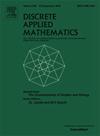Atom divisor graph of a poset
IF 1
3区 数学
Q3 MATHEMATICS, APPLIED
引用次数: 0
Abstract
Let be a poset with least element 0 and . Then is a of . Denote . In this paper, we introduce the atom-divisor graph of , denoted by , it is a graph with the vertex set , and two distinct vertices and are adjacent if and only if . Since is generally not connected, the condition for ADG(P) to be connected is determined. If contains a cycle, then we have shown that its girth is . Moreover, we obtain a class of posets for which the girth of is . We obtain necessary and sufficient conditions for to be in the class of cycles, paths, stars, complete bipartite, complete, complete multipartite, or sun graphs. The bounds on domination and clique number of are determined. Further, we give the class of posets for which is not weakly perfect.
偏序集的原子除数图
让P = (V,≤)是一个偏序集和最小元素0和⊆V。则A r =b∈V∣b≤afor A∈A是A的下锥,记A r 0=A r∈{0}。在这篇文章中,我们介绍了P atom-divisor图,用ADG (P),这是一个图的顶点集P∖{0,1},x和y是相邻的两个截然不同的顶点,如果且仅如果{x, y}ℓ0⊆(P)。由于ADG(P)一般不连接,因此确定ADG(P)连接的条件。如果ADG(P)包含一个循环,那么我们已经证明了它的周长是3或偶数。此外,我们得到了一类ADG(P)的周长为3,4或2n,n≥3的偏置集。得到了ADG(P)属于环图、路径图、星图、完全二部图、完全二部图、完全多部图或太阳图的充要条件。确定了ADG(P)的统治边界和团数边界。进一步,我们给出了一类ADG(P)不是弱完美的偏序集。
本文章由计算机程序翻译,如有差异,请以英文原文为准。
求助全文
约1分钟内获得全文
求助全文
来源期刊

Discrete Applied Mathematics
数学-应用数学
CiteScore
2.30
自引率
9.10%
发文量
422
审稿时长
4.5 months
期刊介绍:
The aim of Discrete Applied Mathematics is to bring together research papers in different areas of algorithmic and applicable discrete mathematics as well as applications of combinatorial mathematics to informatics and various areas of science and technology. Contributions presented to the journal can be research papers, short notes, surveys, and possibly research problems. The "Communications" section will be devoted to the fastest possible publication of recent research results that are checked and recommended for publication by a member of the Editorial Board. The journal will also publish a limited number of book announcements as well as proceedings of conferences. These proceedings will be fully refereed and adhere to the normal standards of the journal.
Potential authors are advised to view the journal and the open calls-for-papers of special issues before submitting their manuscripts. Only high-quality, original work that is within the scope of the journal or the targeted special issue will be considered.
 求助内容:
求助内容: 应助结果提醒方式:
应助结果提醒方式:


